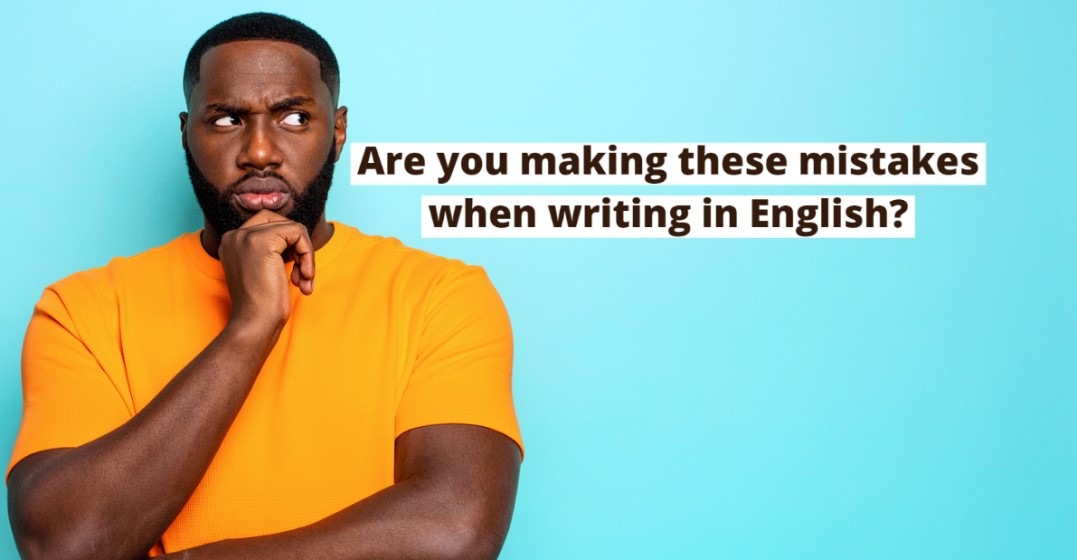Updated on January 9, 2024

Common writing mistakes in English

In this digital world, there are a lot of situations in which the rules of grammar and punctuation don’t matter—when you’re sending a text or an instant message, for example. Even blog writers don’t always follow the rules!
But what if you’re writing a professional document or an academic essay? Those are the times when the rules become important. Let’s dive into some common writing mistakes in English!
Mixing up plural and possessive forms is a mistake that even some native English speakers make.
→ Take an s on the end
→ Nouns that already end in s usually take es.
→ Take ‘s on the end
→ A plural noun can be made possessive by adding only an apostrophe after the final s.
Don’t write: I have five cat’s.
Do write: I have five cats.
Don’t write: This is my mums car.
Do write: This is my mum’s car.
We just told you that an apostrophe is used for possessive nouns. Well, get ready to break those rules!
→ The possessive form of the pronoun it is its (no apostrophe).
→ It’s means it is.
Don’t write: There’s my house. It’s roof is black.
Do write: There’s my house. Its roof is black.
Don’t write: Its a beautiful day.
Do write: It’s a beautiful day.
These two sound similar but have very different meanings!
Then:
→ used in a sequence of events to talk about what happened next
→ refers to a point in time
Than:
→ used with comparative adjectives
→ used for exceptions
Don’t write: I went to the store, than I came home.
Do write: I went to the store, then I came home. (sequence of events)
Don’t write: I’m more excited then you.
Do write: I’m more excited than you. (comparative adjective)
Don’t write: I hate all fish other then salmon.
Do write: I hate all fish other than salmon. (exception)
How do you know when to use which article? Here are some basic rules:
A definite article (the) is used for:
→ specific or unique things: the world, the tree in my garden
→ referring to something you’ve already mentioned
→ a specific group of plural nouns: the students in my class
→ some countries: the United States
→ superlative adjectives: the best cake I’ve ever eaten
An indefinite article (a / an) is used for:
→ singular items: an apple, a shoe
→ general things (things that are not specific or unique)
Don’t write: I bought a new dress. A dress is short.
Do write: I bought a dress. The dress is short. (something you already mentioned)
Don’t write: She said she liked a sweater I was wearing yesterday.
Do write: She said she liked the sweater I was wearing yesterday. (a specific thing)
A comma splice is when you use a comma to connect two or more independent clauses (main ideas).
A comma isn’t enough—you need a stronger form of punctuation like a full stop, semi-colon, or even a colon.
Don’t write: I visited my friend today, we drank coffee.
Do write: I visited my friend today; we drank coffee.
Don’t write: I love to travel, I go on holiday every year.
Do write: I love to travel. I go on holiday every year.
A sentence fragment is an incomplete sentence. Often, sentence fragments come from the wrong use of subordinating conjunctions.
→ Subordinating conjunctions are words like because, so, after, before, as soon as
→ They link a dependent clause (not the main idea) to an independent clause (the main idea) to show the relationship between the two—such as a cause and effect.
→ A dependent clause can’t stand alone; to make a complete sentence, it must be connected to an independent clause.
Don’t write: Because I passed my exam. (This is the cause, but what’s the effect or result?)
Do write:I’m going to celebrate because I passed my exam. (I’m going to celebrate is an independent clause.)
Don’t write: So I asked her on a date. (This is the effect, but what’s the cause?)
Do write: I liked her, so I asked her on a date. (I liked her is an independent clause.)
Understanding the rules of writing is never a bad idea. Even if most of your communication happens on your phone, you never know when you’ll need some writing skills!
Start your free 7-day trial with Lingoda to help you avoid making any mistakes in the future!